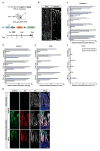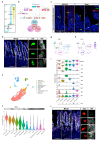An Approach to Intersectionally Target Mature Enteroendocrine Cells in the Small Intestine of Mice
- PMID: 38201306
- PMCID: PMC10778503
- DOI: 10.3390/cells13010102
An Approach to Intersectionally Target Mature Enteroendocrine Cells in the Small Intestine of Mice
Abstract
Enteroendocrine cells (EECs) constitute only a small proportion of Villin-1 (Vil1)-expressing intestinal epithelial cells (IECs) of the gastrointestinal tract; yet, in sum, they build the largest endocrine organ of the body, with each of them storing and releasing a distinct set of peptides for the control of feeding behavior, glucose metabolism, and gastrointestinal motility. Like all IEC types, EECs are continuously renewed from intestinal stem cells in the crypt base and terminally differentiate into mature subtypes while moving up the crypt-villus axis. Interestingly, EECs adjust their hormonal secretion according to their migration state as EECs receive altering differentiation signals along the crypt-villus axis and thus undergo functional readaptation. Cell-specific targeting of mature EEC subtypes by specific promoters is challenging because the expression of EEC-derived peptides and their precursors is not limited to EECs but are also found in other organs, such as the brain (e.g., Cck and Sst) as well as in the pancreas (e.g., Sst and Gcg). Here, we describe an intersectional genetic approach that enables cell type-specific targeting of functionally distinct EEC subtypes by combining a newly generated Dre-recombinase expressing mouse line (Vil1-2A-DD-Dre) with multiple existing Cre-recombinase mice and mouse strains with rox and loxP sites flanked stop cassettes for transgene expression. We found that transgene expression in triple-transgenic mice is highly specific in I but not D and L cells in the terminal villi of the small intestine. The targeting of EECs only in terminal villi is due to the integration of a defective 2A separating peptide that, combined with low EEC intrinsic Vil1 expression, restricts our Vil1-2A-DD-Dre mouse line and the intersectional genetic approach described here only applicable for the investigation of mature EEC subpopulations.
Keywords: Cck-expressing I cell; Cre/loxP; Dre/rox; EEC; Gcg-expressing L cell; Sst-expressing D cell; enteroendocrine cells of small intestine.
Conflict of interest statement
The authors declare no conflict of interest.
Figures




Similar articles
-
Single cell transcriptomic profiling of large intestinal enteroendocrine cells in mice - Identification of selective stimuli for insulin-like peptide-5 and glucagon-like peptide-1 co-expressing cells.Mol Metab. 2019 Nov;29:158-169. doi: 10.1016/j.molmet.2019.09.001. Epub 2019 Sep 7. Mol Metab. 2019. PMID: 31668387 Free PMC article.
-
Mature enteroendocrine cells contribute to basal and pathological stem cell dynamics in the small intestine.Am J Physiol Gastrointest Liver Physiol. 2018 Oct 1;315(4):G495-G510. doi: 10.1152/ajpgi.00036.2018. Epub 2018 May 31. Am J Physiol Gastrointest Liver Physiol. 2018. PMID: 29848020 Free PMC article.
-
Enteroendocrine cells switch hormone expression along the crypt-to-villus BMP signalling gradient.Nat Cell Biol. 2018 Aug;20(8):909-916. doi: 10.1038/s41556-018-0143-y. Epub 2018 Jul 23. Nat Cell Biol. 2018. PMID: 30038251 Free PMC article.
-
Evolving Concepts and Translational Relevance of Enteroendocrine Cell Biology.J Clin Endocrinol Metab. 2016 Mar;101(3):778-86. doi: 10.1210/jc.2015-3449. Epub 2015 Dec 9. J Clin Endocrinol Metab. 2016. PMID: 26649620 Review.
-
Enteroendocrine cell differentiation and function in the intestine.Curr Opin Endocrinol Diabetes Obes. 2022 Apr 1;29(2):169-176. doi: 10.1097/MED.0000000000000709. Curr Opin Endocrinol Diabetes Obes. 2022. PMID: 35066539 Free PMC article. Review.
References
Publication types
MeSH terms
Substances
Grants and funding
LinkOut - more resources
Full Text Sources
Molecular Biology Databases

